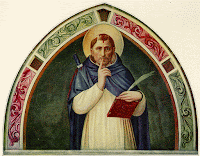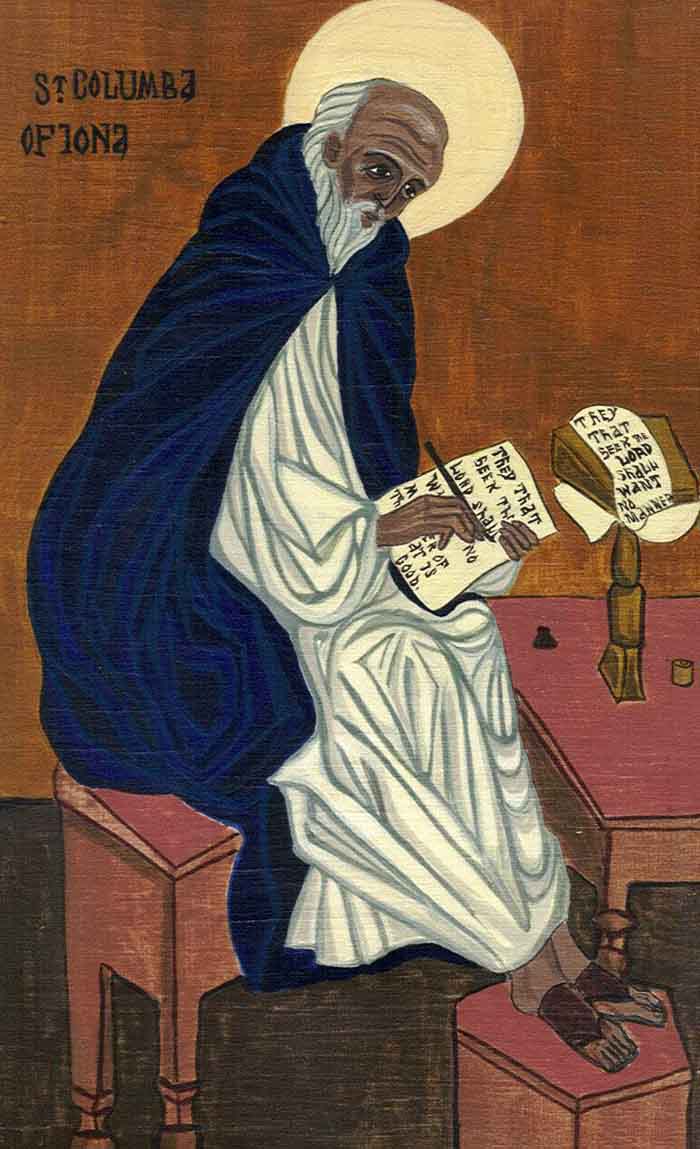O Sapientia
16 December - Sarum
17 December - Roman
The Great O Antiphons begin for the modern Roman Church on the 17th December and are seven in number. A solid claim is made that these chants were first written in the 8th or 7th centuries taking titles from the Prophecy of Isaiah, other prophets, and Wisdom Literature and applying them to the Lord Jesus in anticipation of his birth. These antiphons are sung with the Magnificat at Vespers which makes the Great O Antiphons a deeply Marian reflexion upon the Lord's Advent and birth.
The tradition found in northern Europe is rather different, and modern folk like to belittle mediaeval textual evidence as unworthy intrusions into that vast august purity of the original forms ... since of course we were all there to know exactly what that original was -- so by all means, ad fontes! *cough*
Dear Reader, you may have surmised that my sympathies are with the Sarum tradition as part of the organic development of the liturgy ... or perhaps a more ancient memory of something we can no longer find in our limited texts of the past. The Sarum number of antiphons is eight, and they begin on the 16th of December.
For most Roman Catholics today, if the tradition isn't 20th c. Roman, then it isn't. But that is not the way the Church in the West has been for most of her life.
One example of note: the custom was until recently that the O Antiphons were sung thrice. The antiphon would be sung prior to the Magnificat. Then the same antiphon would be sung at the end of the Magnificat but before Gloria Patri, and then the antiphon would be sung again after the Gloria Patri for the third time. I believe somewhere Dom Prosper Guéranger wrote of this trinitarian method and its relevance to the Great O Antiphons.
One example of note: the custom was until recently that the O Antiphons were sung thrice. The antiphon would be sung prior to the Magnificat. Then the same antiphon would be sung at the end of the Magnificat but before Gloria Patri, and then the antiphon would be sung again after the Gloria Patri for the third time. I believe somewhere Dom Prosper Guéranger wrote of this trinitarian method and its relevance to the Great O Antiphons.
We should be mindful that with regard to the Eight O Antiphons of the Sarum Use the textual evidence is to be found throughout northern Europe all the way down to Switzerland. This 8 O Antiphon custom was widely established and may have been the dominant pattern rather than the Roman method circa the Council of Trent. (It is sad to see a book like the Church of England's Common Worship
abandon something native and integral to worship in the British Isles
and elsewhere and instead to suddenly go ultramontane and abandon the
8th Antiphon and start the O Antiphons on the 17th of December like any
Roman Catholic.)
The first 7 antiphons are addressed to Christ with Isaiah, other Hebrew prophets and the Wisdom Literature as the wellspring for the pattern of titles and texts. But the 8th antiphon concerning Our Lady ("O Virgo virginum") also has its heart in Isaiah and makes a textual connexion to that remarkable text "O Magnum Mysterium" (wherein we find a mystery of textual traditions regarding Habbakuk as partial source for the text and its variant forms).
Among the mediaeval texts we find some communities with 12 antiphons so that the sacred number be achieved with its reference to the 12 Tribes of Israel and the 12 Apostles. In Paris, at one point, there were nine antiphons. The Marian character of the O Antiphons is consistent in every case as they clothe the singing of the Magnificat, Our Lady's Canticle. The 7 Antiphons directed to Christ find their completion with the 8th directed to the Mother but also about her Son more than herself ... her Son the 'mysterium' in Himself.
Also in the 8 Antiphons is a mystical catechesis upon the Days of Creation. As God made Adam and from Adam made Eve, so here God recreates the Days of Creation ... instead of man made first and then woman, we see God creates Woman first (Fiat Maria!) and then makes the Man from Her, even Jesus from Mary gaining his full humanity through her. AND through this most sacred reversal of order and the setting out of Divine Recreation of Mankind, the Creation is healed in a way that can only be called mysterion and sacrament, as we find in the textual variations of "O Magnum Mysterium".
(To underline ever so gently my theme, I note that "O Virgo virginum" still appears in the Graduale of the Premonstratensian Order, and I believe is still sung in some if not all of the Orders monasteries. For this reason among others, I cherish my copies of all things Premonstratensian.)
The first 7 antiphons are addressed to Christ with Isaiah, other Hebrew prophets and the Wisdom Literature as the wellspring for the pattern of titles and texts. But the 8th antiphon concerning Our Lady ("O Virgo virginum") also has its heart in Isaiah and makes a textual connexion to that remarkable text "O Magnum Mysterium" (wherein we find a mystery of textual traditions regarding Habbakuk as partial source for the text and its variant forms).
Among the mediaeval texts we find some communities with 12 antiphons so that the sacred number be achieved with its reference to the 12 Tribes of Israel and the 12 Apostles. In Paris, at one point, there were nine antiphons. The Marian character of the O Antiphons is consistent in every case as they clothe the singing of the Magnificat, Our Lady's Canticle. The 7 Antiphons directed to Christ find their completion with the 8th directed to the Mother but also about her Son more than herself ... her Son the 'mysterium' in Himself.
Also in the 8 Antiphons is a mystical catechesis upon the Days of Creation. As God made Adam and from Adam made Eve, so here God recreates the Days of Creation ... instead of man made first and then woman, we see God creates Woman first (Fiat Maria!) and then makes the Man from Her, even Jesus from Mary gaining his full humanity through her. AND through this most sacred reversal of order and the setting out of Divine Recreation of Mankind, the Creation is healed in a way that can only be called mysterion and sacrament, as we find in the textual variations of "O Magnum Mysterium".
(To underline ever so gently my theme, I note that "O Virgo virginum" still appears in the Graduale of the Premonstratensian Order, and I believe is still sung in some if not all of the Orders monasteries. For this reason among others, I cherish my copies of all things Premonstratensian.)
Ah! But I am not even touching upon the most important matter to me which is the rich legacy of God Incarnate as both Word and Wisdom of God. For now I will focus in a bit on the Roman Church's title for St. Mary as Sedes Sapientiae, the Seat of Wisdom. But, dear Reader, there is so much more that has been set aside or overlooked which beholds Lady Wisdom not as divine, not as an expression of Jesus' identity, but rather Lady Wisdom is hymned as the very first creature of Creation who –when the fulness of time arrived– would become Mary of Nazareth, the Mother of God the Wisdom in the flesh.
I am thinking especially of a French mystical poet of the last century whose most extraordinary Marian work remains untranslated or at least unavailable at the present time. Not unlike Thomas Traherne, this poet enters into ecstasies of contemplation of the Blessed Mother and especially of her as Lady Wisdom. (How the 'people of God' filled with the spirit of Vatican II would turn apoplectic over that...) What wondrous depths there are in the mystical experiences of the laity! (that are such a threat to the minions of bureaucracies wherever there is a cathedral).
Salvation does not depend upon such things as the number of antiphons or the dates when one must chant them, dear Reader, but it is my
duty as perhaps one of the last of the Sarum-loving liturgical dinosaurs
to do my part and 'splain it plain.
In short, if you are on the side of the Child Jesus, St. Joseph of Arimathea, the Blessed Virgin Mary, Saint Anne, and the Thorn Tree, then you know that there are 8 antiphons to be sung, and we began with O Sapientia on 16 December.
If you are of those who see the world as having begun with twentieth century scholarship and Vatican II or if you see the world through the Council of Trent, then the O Antiphons began today, the 17th of December.
Dominicans chanting O Sapientia for 17 December
Of course, be well-behaved and observe the custom of the house in which you reside, dear children, but in your own chambers you are Lord or Lady of your castle and its chapel ... and you may light your Advent Wreath and chant your Magnificat with 8 Antiphons for the love of Our Lord and Our Lady, and all shall be well, and all shall be well, and all manner of thing shall be well.
NOTES: ‘Mary Mother of Divine Grace Compared to the Air we Breathe. Stonyhurst, May ’83.’ Autograph in A.—Text and title from later autograph in B. Taken by Dean Beeching into ‘A Book of Christmas Verse’ 1895 and thence, incorrectly, by Orby Shipley in ‘Carmina Mariana’. Stated in a letter to R. W. D. June 25, ’83, to have been written to ‘hang up among the verse compositions in the tongues.... I did a piece in the same metre as Blue in the mists all day.’ Note Chaucer’s account of the physical properties of the air, ‘House of Fame’, ii. 256, seq.
O Adonai
17 December - Sarum
18 December - Roman
Healey Willan's 1957 setting of "The Great O Antiphons of Advent" —once beloved by Anglicans and Lutherans alike— are available as sheet music from Concordia by clicking here.
+
















